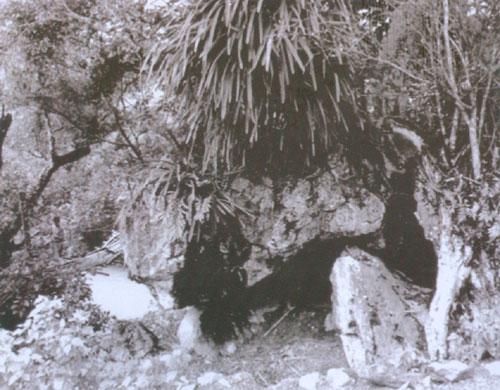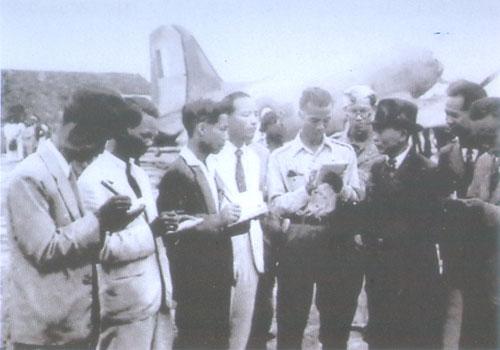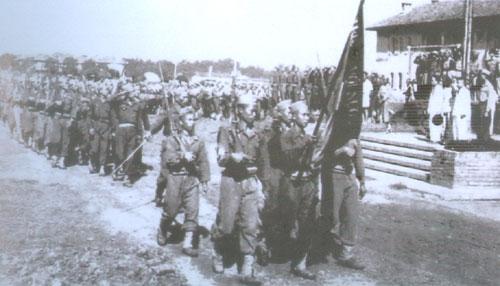Chi tiết tin - Quảng Bình (Tiếng Anh)
Pre-uprising period, general uprising & establishment of democratic republic of Vietnam
In December 1944, Uncle Ho entrusted him with the task of building the Vietnamese Mobilization and Liberation Army-the predecessor of the Vietnamese People’s Army of today. Only two days after its establishment, the unit comprised of 34 soldiers, with rudimentary weapons, who had never been through any training, wiped out two military outposts, Phai Khat and Na Ngan which were commanded by French officers.
In late March 1945, the Vietnamese Mobilization and Liberation Army merged with the National Salvation Army to form the Viet Nam Liberation Army. At the Plenum of the Indochinese Communist Party Central Committee in 1945, Vo Nguyen Giap was appointed to the Party Central Committee and became Member of the Party Standing Committee. He also took part in the National Uprising Committee and the Vietnamese National Liberation Committee.
At that time, he was informed that Nguyen Thi Quang Thai had passed away in Hoa Lo prison.
On August 14, 1945, after the National Congress in Tan Trao decided to launch the General Uprising, Vo Nguyen Giap led the Việt Nam Liberation Army to free Thai Nguyen provincial capital, which was then occupied by the Japanese.
After the success of the August Revolution, Vo Nguyen Giap became Minister of the Interior in the provisional Revolutionary Government.
Pre-uprising period
In 1941, Vo Nguyen Giap went to Cao Bang assigned to build revolutionary base within ethnic minority community.
In December 1944, Ho Chi Minh entrusted Vo Nguyen Giap with a task of building the Vietnamese Mobilization and Liberation Army.
In late March 1945, the Vietnamese Mobilization and Liberation Army merged with the National Salvation Army to form the Việt Nam Liberation Army.
The first 34 members of the Vietnamese Mobilization and Liberation Army were selected from various guerrilla teams in Cao Bang, Bac Kan and Lang Son provinces.
 |
 |
|
A stele at Tran Hung Dao forest (Cao Bang) on which the names of the 34 first soldiers of the Vietnamese Mobilization and Liberation Army were carved |
 |
|
The Vietnamese Mobilization and Liberation Army was established on December 12 1944 at Tran Hung Dao Forest, Nguyen Binh canton (present-day Nguyen Binh district), Cao Bang |
|
|
|
The Phay Khat outpost in Cao Bang which was wiped by the Vietnamese Mobilization and Liberation Army |
 |
|
During his secret operation in the Viet Bac revolutionary base, all mean of letters and communication had to be performed by a secret mail drop of Comrade Vo Nguyen Giap at Bach Dich commune |
 |
|
Vo Nguyen Giap reporting to Ho Chi Minh about preparation for the National Party Congress to take place at Na Lua hut in August 1945 |
 |
|
Na Lua hut (Tan Lap, Tan Trao, Tuyen Quang) where Ho Chi Minh usually meet with Vo Nguyen Giap and other members of the Party Central Committee |
General uprising in August 1945
On August 13, 1945, President Ho Chi Minh chaired the National Party Congress at Tan Trao, Tuyen Quang, to decide to launch the General Uprising to be led by General Secretary of the Party Central Committee Truong Chinh. On August 16, 1945, the opening of the National Congress took place in Tan Trao communal house. There, the Viet Nam National Liberation Committee was founded. This Committee functioned as a provisional government of the Democratic Republic of Viet Nam. Ho Chi Minh was President.
Within 12 days (from August 14 to 25, 1945), the August Revolution was victorious an over the country.
On August 19, 1945, the General Uprising was a complete success in Ha Noi. The power, at both central and local levels, returned to the Vietnamese civilians.
 |
|
|
 |
|
In response to the Appeal of the Uprising Committee, the people of Ha Noi seized power at Bac Bo Phu (Residence of Resident-Superior of Tonkin) on August 19, 1945 |
 |
|
President Ho Chi Minh and Minister of Interior Vo Nguyen Giap and "The Deer Team" of Americans by Alison Thomas in a memorial picture taken in Ha Noi. The group was sent to Viet Bac by the Allies, and stayed from July 16 to September 9, 1945 to provide support to Viet Nam in the struggle against Japanese fascist. Of seven weeks, Thomas spent four weeks giving military training courses to approximately 200 people who would later become the leaders of the Vietnamese People’s Army |
 |
|
Minister of lnterior Vo Nguyen Giap in a discussion with "The Deer Team" |
 |
|
Uncle Ho and Military Commissioner Vo Nguyen Giap at Bac Bo Phu (Residence of Resident-Superior of Tonkin) after the August 1945 Revolution |
 |
|
In accordance with the Potsdam Agreement, (in Germany), the Allied Forces would lay down Japanese arms in Indochina. The first US Mission led by intelligent officer A. Patti arrived in Ha Noi. On August 30, 1945, the Vietnam Revolutionary Government organized a formal welcoming ceremony. On such occasion, on behalf of the Viet Nam government, Vo Nguyen Giap and A. Patti saluted the color. This was the first official diplomatic protocol of the Democratic Republic of Viet Nam |
 |
|
Commander of the Vietnam Liberation Army Vo Nguyen Giap reviewing the first military parade in Ha Noi on August 26, 1945 after the Viet Minh seized power |
Present-day socialist republic of Vietnam
As suggested by President Ho Chi Minh that national interest must be prioritized, the National Liberation Committee was reformed to be the Provisional Government (August 28, 1945). Several commissioners volunteered to retire and invited other patriot intellectuals to take over. The National United Front was supposed to be extensive and representative become capable of dealing with country affairs. On September 2, 1945, the birth of the Democratic Republic of Viet Nam was proclaimed, starting a new era of independence and freedom. It was also the first time the Provisional Government presented themselves in front of then fellow-citizens.
 |
|
Minister of Interior Vo Nguyen Giap and members of the Provisional Revolutionary Movement of the Democratic Republic of Viet Nam and President Ho Chi Minh (August 28 1945) |
 |
|
President Ho Chi Minh read the Declaration of Independence, announcing the birth of the Democratic Republic of Viet Nam (present-day Socialist Republic of Viet Nam) at Ba Dinh Square, Ha Noi, September 2, 1945 |
 |
|
President Ho Chi Minh and Chairman of the General Military Commission Vo Nguyen Giap on September 2, 1945. |
 |
|
A parade at Ba Dinh Square, Ha Noi, President Ho Chi Minh reading "Declaration of Independence", September 2, 1945 |
 |
|
Vo Nguyen Giap, Chairman of the Resistance Committee, and other members of the Resistance Coalition Government of Democratic Republic of Viet Nam led by President Ho Chi Minh on March 2 1946 |
 |
|
President Ho Chi Minh (sitting). From left to right: Minister of Finance Pham Van Dong, Chairman of the Ha Noi Administrative Committee Tran Duy Hung, General Secretary of the Indochinese Communist Party Truong Chinh and Minister of Interior Vo Nguyen Giap |
 |
|
On October 8, 1945, President Ho Chi Minh, Pham Van Dong, Vo Nguyen Giap (the third from right), Tran Huy Lieu, Vu Dinh Hoe, Adviser Vinh Thuy, Nguyen Van To and Cu Huy Can attending the opening ceremony of a course to train teachers that teach Vietnamese characters, at a lecture hall of the Indochina University. |
 |
|
On October 21, 1945, Member of the Military Commission Vo Nguyen Giap and Minister of Finance Pham Van Dong attending the opening ceremony of a training course of the Politico-Military School to train military knowledge and skills for the revolutionary armed forces organized in Ha Noi. |
 |
|
On December 3, 1945, President Ho Chi Minh (center), Minister of Interior Huynh Thuc Khang (standing to the right of Ho Chi Minh) and Vo Nguyen Giap (standing to the left of Ho Chi Minh) attending the opening ceremony of Vietnamese Ethnic Minorities Conference in Ha Noi |
 |
|
On April 16, 1946, the Delegation of the Democratic Republic of Vietnam attending the Da Lat Preparation Conference. There, Deputy Head of the Delegation Vo Nguyen Giap responded to interviews from domestic and international journalists at Gia Lam airport, before the plane took off. |
 |
|
On May 26th, 1946, President Ho Chi Minh, and Head of the Military Commission Vo Nguyen Giap (with the hat) and Minister of Defense Phan Anh attending the opening ceremony of a new academic year at the Tran Quoc Tuan Military College in Son Tay. |
 |
|
Minister of Defense Vo Nguyen Giap and members of the Revolutionary Government led by President Ho Chi Minh (November 3, 1946). |
 |
|
Acting President Huynh Thuc Khang and Secretary of the General Military Commission Vo Nguyen Giap reviewing the parade along Hoan Kiem Lake (Sword Lake) in Ha Noi, September 2, 1946. |
 |
|
September 2, 1946, on the first anniversary of the birth of the Democratic Republic of Vietnam, Secretary of the General Military Commission Vo Nguyen Giap read the Order of the Day. |
Source: "Commander-in-chief General Vo Nguyen Giap" Book
- International friendship (26/10/2013)
- Vo Nguyen Giap: Vietnam’s last centurion* (27/10/2013)
- Hometown, youth and revolution (23/10/2013)
- General Vo Nguyen Giap's devotion to science-technology, culture and art (19/10/2013)
- An exemplary man (19/10/2013)
- The book “Dien Bien Phu: five miracles never seen before in history of war” in Egyptian (17/10/2013)
- Palestinian newspaper carries book on Dien Bien Phu battle (17/10/2013)
- Contributions of General Vo Nguyen Giap highlighted (17/10/2013)
- A passenger through the century (15/10/2013)
- General Giap - an unfailing light for Vietnamese people (11/10/2013)




